Miliou - Winner 2019
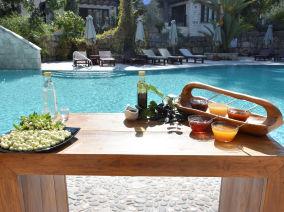
Winner in the ‘Health and wellbeing tourism’ category
The village of Miliou will give you the opportunity to see natural beauties, experience the healing spring waters, learn about the culture as well as taste traditional Cypriot food and delicacies.
The local community will warmly welcome you, maintaining high standards of personal and professional wellbeing to meet all your needs.
What makes Miliou special
Miliou is a small, quiet and beautiful village hidden among orange trees with most of its buildings retaining the local architecture. The village provides a unique travel experience that combines wellness, relaxation and exploration of an idyllic and peaceful environment. Miliou has been known for a long time due to the area’s therapeutic healing water. The community of Miliou is ideal for unique and unforgettable experiences and offers a peaceful oasis and moments of total relaxation to those who wish to escape from stress and the routine of everyday life.
Health and wellbeing tourism
Well-known for its spring waters, Miliou is one of the smallest villages in Cyprus, in the Paphos District, with only 70 permanent citizens.
The destination offers a natural healing spa that preserves the local architectural tradition, built with stone and wood and is considered as eco-friendly hotel.
Come and enjoy the healing ability of the spring waters, enjoy and relax with the high-quality spa treatments developed scientifically by leading experts from Cyprus and abroad.
People with medical issues can be treated accordingly since the mineral-rich Sulphur waters of the Ayia Anastasia spring is ideal for conditions such as arthritis, rheumatism, gout and joint pain. Moreover, nature lovers can wander in the green scenery enjoying the rich environment and hiking at ‘Anerades’ nature trail. In general, visitors will definitely experience the Cypriot hospitality by visiting the local tavern and taste the traditional Cypriot dishes.
Sightseeing tips
- The 17th century Church of Ayioi Anargyroi, built to honour St. Cosmas and St. Damianos who used the sulphuric spring waters to heal people from all over Cyprus and Egypt
- The circular ‘Anerades’ nature trail offers three paths where visitors can enjoy nature (oak trees, old olive trees, almond trees, vineyards, lemon trees and many more) while wandering in the area.
- At the annual Orange Festival, you can enjoy various orange derivatives like orange infused beer, juice, honey, tea, marmalade and many more traditional dishes and sweets.
More information
- The official Miliou website
- EDEN video about Miliou - Winner 2019
- EDEN contact for Miliou: evamiliou
 hotmail [dot] com (evamiliou[at]hotmail[dot]com)
hotmail [dot] com (evamiliou[at]hotmail[dot]com)
Orini Larnakas - Winner 2017

Winner in the Cultural Tourism category
The region of Orini Larnaka is located northwest of the city of Larnaka and consists of 18 local authorities (17 communities and 1 municipality).
Orini Larnaka has a long course of historical and cultural evolution and is characterised by a cultural ‘mosaic’, consisting of archaeological sites, churches and monasteries, traditional villages, traditional arts and professions that were shaped through the centuries. Events and festivals aim to highlight the countryside, the cultural elements and original features, farming, local products, traditional cuisine and the daily life of residents.
Orini Larnaka won partly due to the excellent cooperation between the 18 communities forming the mountainous Larnaka, the Larnaka Tourism Board and the Women Association of Rural Larnaka.
What makes Orini Larnaka special?
Orini Larnaka is a cultural destination with its beginnings rooted in ancient times. It has been described as a cultural 'mosaic' composed of some uniquely beautiful churches, chapels and monasteries, archaeological sites, and traditional settlements. These sites are interesting from a religious and historical perspective, some dating from the 12th century. The Neolithic settlements in Choirokitia (UNESCO World Heritage site) and Kalavasos have been well-preserved and are definitely worth a visit.
Cultural tourism
Step into the area's museums and get a deeper understanding of the exceptional culture of the region. Some of these include the 'Local Ethnological Museum of Traditional Embroidery and Silversmith Work', the 'Handicraft Centre' in Lefkara, the 'Local Rural Museum' and the 'Bee Museum' in Kato Drys.
Witness ancient arts and folkloric crafts such as silversmiths in Pano and Kato Lefkara, pottery makers in Kornos and basket-weaving craftsmen in Choirokitia. There aren't many individuals left using traditional tools and methods, so this is a fleeting opportunity. Pano and Kato Lefkara are world-renowned for the Lefkaritiko embroidery which is on UNESCO’s list of Intangible Cultural Heritage.
Orini Larnaka has kept its appearance and special characteristics unchanged through the passage of time, with almost all of the cores of the communities listed as traditional and with areas controlled by the Department of Antiquities in Cyprus. The archaeological finds from the Neolithic period in Choirokitia and in the Tenta site in Kalavasos have generated huge archaeological interest.
Once you've gotten your fill of traditional craftsmanship, archaeological sites and ancient churches Orini Larnaka has more to offer. Unique natural environment and natural trails for the nature lovers. Recreational activities such as cycling, hiking, picnic sites, wine route Orini Larnaka-Nicosia.
Sightseeing tips
The civilisation of Cyprus spans about 90 centuries, according to the archaeological excavations carried out from time to time on the island. The cultural heritage of the island also includes Hellenistic and Roman monuments, Byzantine and Latin churches and monasteries, Frankish and Venetian forts and castles of the 12th - 16th centuries A.D., Muslim temples, architecture, folk art, visual arts and many other forms of culture:
- Neolithic settlement of Choirokitia
- ‘Tenta’ Neolithic settlement in Kalavasos
- Local Ethnological Museum of Traditional Embroidery and Silversmith Work (Lefkara)
- The Church of the Timios Stavros (Holy Cross) in Lefkara
- Monastery of Agios Minas
- The Panagia of Kofnou
- The Venetian Watermill at Agios Theodoros
More information
- Orini Larnaka website (in English)
- EDEN video about Orini Larnaka - Winner 2017
- EDEN contact for Orini Larnaka: info
 larnakaregion [dot] com (info[at]larnakaregion[dot]com)
larnakaregion [dot] com (info[at]larnakaregion[dot]com)
Pitsilia region - Winner 2015
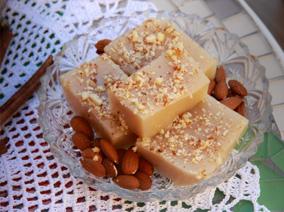
Winner in the Tourism and Local Gastronomy category
The picturesque Pitsilia region is the most gastronomically-varied mountainous region of Cyprus. It includes villages on both the north and south sides of the Troodos Geopark. The villages of Pitsilia still retain their traditional architecture to a great extent, bearing witness to their long and rich history. Some are built on steep mountainsides among vineyards while others are spread out along cultivated green valleys.
The four main villages of the Pitsilia region are Agros, Palechori, Pelendri and Kyperounda. These four, and many others, make up this part of Cyprus, which some have called 'an earthly paradise'. The region is especially well-known for its traditional products such as fragrant rose water, gammon, sausages, soujoukos (made from grape must), lountza (smoked pork loin), varied sweets and jams, liqueurs and types of bread. The renowned Commandaria wine and the authentic Cypriot spirit, Zivania, hold an important place in the region's gastronomic wealth.
The changing landscape, the seasonal variety of colours, the UNESCO accredited Byzantine churches and the warm hospitality of the residents, combine to make Pitsilia one of the most attractive regions in Cyprus.
Local gastronomy
The Pitsilia region is known for the manufacture of a broad range of local agricultural products as well as processed goods that reveal the expertise and traditions of its residents.
Pitsilia offers small-scale accommodation focusing on agro-tourism. Visitors should have their own vehicle in order to travel to the villages in the region since public transportation is limited.
The destination offers authentic tourism experiences since visitors can combine the rich nature with the taste of the local traditional dishes. Visitors can ask for the local traditional recipes or they can participate in workshops and learn about the secrets of Cypriot gastronomy.
Sightseeing tips
- Try the local Commandaria wine in Zoopigi village. A glass of Commandaria after a meal is a unique pleasure and the perfect aid to relaxation after a tiring day.
- Visit Agros, one of the main villages in the Pitsilia area, which is famous for the production of rose water and spoon sweets. Explore the area and learn about the production of Pitsilia’s cured meat as well as the cultivations of Rosa Damascene.
- Participate in the Apple Festival in the picturesque village of Kyperounta. Every year in October, thousands of visitors from all over Cyprus and from abroad, come to the festival to try everything that is made by the villagers, including milouze (the apple version of grape-based palouze) apple juice, apple cakes, apple liqueur, apple pie, apple zivania and much more.
- Walk the 'Teisia' geological trail to the top of the Madari mountain peak, and admire the panoramic view and rich environment.
- Cycle the bike routes that connect Nicosia and Pitsilia and visit the remarkable hazelnut forest in Pitsilia.
More information
- The official website of the Pitsilia region
- EDEN video about the Pitsilia region
- EDEN contact for the Pitsilia region: k [dot] vasiliou
 anetroodos [dot] com (k[dot]vasiliou[at]anetroodos[dot]com)
anetroodos [dot] com (k[dot]vasiliou[at]anetroodos[dot]com)
Polis Chrysochous Municipality - Winner 2013
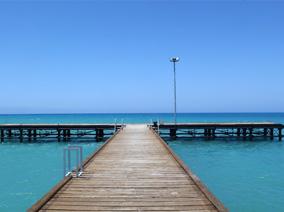
Winner in the Accessible Tourism category
The Municipality of Polis Chrysochous is an ideal tourist destination.
It offers natural scenic beauty, abundant greenery, attractive beaches, a distinctive style of architecture and hospitable people with a rich culture and history.
Tourists looking to escape the stress and routine of daily life will find a place of calm and rest in an environment of unparallelled beauty.
Accessibility
Polis Chrysochous has the necessary infrastructure to give visitors - regardless of age or physical condition - an unforgettable experience.
Tourists can enjoy peace and tranquillity in a pleasant, friendly environment. For the more adventurous, there is also the possibility of a more active holiday.
There are many services that make Polis Chrysochous a unique tourism destination for visitors with special needs:
- wheelchair-accessible accommodation
- adapted mini bus and taxi services
- wheelchair-accessible seaside pavements
- a unique electronic system for access to the sea.
Sightseeing tips
- Visit the Church of Agios Andronikos, with its 16th century wall paintings and the traditional 18th century single nave Church of AgiaKyriaki.
- Discover the Akamas National Park, a unique area with a remarkable variety of fauna, flora, geological features, beautiful landscapes and beaches. Visitors can enjoy nature trails, the botanical garden and the Baths of Aphrodite.
- Enjoy the 'Summer Nights' and the 'Marion-Arsinoe Cultural Days' which include theatrical performances, concerts and sports activities.
- Come for World Tourism Day on 27 September and taste traditional local products at the 'Traditional Products and Folklore Day'.
More information
- The official website of Polis Chrysochous Municipality
- See the EDEN video about Marathon:
- Long version (3 minutes)
- Short version (1 minute)
- EDEN contact for Polis Chrysochous Municipality: polismunicipality
 cytanet [dot] com [dot] cy (polismunicipality[at]cytanet[dot]com[dot]cy)
cytanet [dot] com [dot] cy (polismunicipality[at]cytanet[dot]com[dot]cy)
Kalopanayiotis - Winner 2011
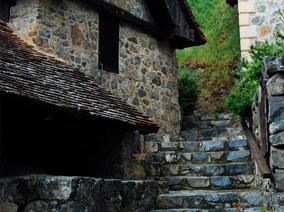
Winner in the Tourism and Regeneration of Physical Sites category
The small village of Kalopanayiotis is situated in the Marathasa region, on the northern slopes of the Troodos Mountain Range, 700 metres above sea level.
This beautiful village offers traditional architecture, thermal springs and luscious green valleys.
The tiled rooftops, stunning balconies, quiet courtyards, cobblestone paths and ancient churches all contribute to the elegant setting.
Kalopanayiotis is also famous for its thermal springs. The healing properties of these springs were famous in antiquity, when the Romans, Byzantines and Franks used to visit the village.
The Setrachos River, along with numerous watermills and natural springs provide a tranquil and peaceful atmosphere.
Regeneration and revival
In recent years, the local authorities with the support of the government and the EU have initiated several regeneration projects in order to revive the village. Maintaining its rich architectural and cultural identity was a core aspect of the programme, and this is reflected in all the initiatives executed.
For example an old school next to the Monastery of Agios Ioannis Lampadistis has been renovated and transformed into a museum. It now hosts an impressive collection of Byzantine art, ecclesiastical artefacts and antiques.
The house of National Martyr Lavrentios is another example of sustainable regeneration at its best. This glorious building has been restored and converted into a cultural and conference centre for the community. A number of houses have been renovated into agrotourism accommodation.
It was also important that the village regained its reputation as a great therapeutic center with healing springs. Today, the ancient spa village of Kalopanayiotis is a regenerated destination, ready to welcome guests from Cyprus and beyond. It is a place that combines sightseeing, nature, health and tradition, in a truly beautiful way.
Sightseeing tips
- Try 'soutzoukos', a local sweet made from grapes and almonds. Several shops in Kalopanayiotis sell this local delicacy.
- Visit the trout farm next to the Kalopanayiotis dam, where fishing is permitted.
- Enjoy a walk through the nature trail which leads to Kykkos Water Mill, a 17th century monument that was recently renovated.
- Join a daily excursion from Kalopanayiotis. There are traditional villages with small factories producing local products, as well as monuments, museums and traditional restaurants.
More information
- The official website of Kalopanayiotis
- See the EDEN video about Kalopanayiotis:
- Long version (3 minutes)
- Short version (1 minute)
- EDEN contact for Kalopanayiotis: stavros
 eea [dot] com [dot] cy (stavros[at]eea[dot]com[dot]cy)
eea [dot] com [dot] cy (stavros[at]eea[dot]com[dot]cy)
Kato Pyrgos - Winner 2010

Winner in the Aquatic Tourism category
Kato Pyrgos is a small village of almost 1,500 people in the Tylliria area in western Cyprus. It is one of the few villages left in Cyprus where the natural environment remains virtually untouched and maintains its natural beauty.
It is a place rich in history and heritage, lying on the roots of the Troodos Mountain range with a stunning view of the sea. The community offers a unique and rare sea, mountain and freshwater combination which everyone can enjoy.
The beaches in Kato Pyrgos are famous for their cool and lucid waters, ideal for the hot summer months. The beaches are some of the cleanest on the island, and if you are lucky you might spot a school of dolphins playing far out in the sea.
Kato Pyrgos is also an ideal spot for freshwater fishing and hiking.
Rich in history and culture, Kato Pyrgos hosts many monuments, chapels and churches. Findings from the 14th century and tombs from the Hellinistic and Roman period can be found in an area next to the village.
Moreover, visitors can see the Chapel of Virgin Mary 'Galoktisti' that was built around the 12th century. According to elderly residents of the village the chapel was built with milk ('galoktisti' means 'built with milk' in Greek).
What makes Kato Pyrgos special?
When strolling through the narrow streets of Kato Pyrgos - admiring centuries old architecture, buying fragrant figs and peaches, inhaling the sea air and enjoying the Mediterranean sun - life seems to take a pause.
The locals enjoy telling the visitors about the legends of the area and encourage them to participate in the local activities.
Don't miss...
- the Chapel of Virgin Mary 'Galoktisti'
- the oak tree in the village square which is nearly 110 years old.
More information
- The official website of Kato Pyrgos
- Watch the EDEN video about Kato Pyrgos:
- Long version (3 minutes)
- Short version (1 minute)
- EDEN contact for Kato Pyrgos: katopirgos
 hotmail [dot] com (katopirgos[at]hotmail[dot]com), ksimvoulio
hotmail [dot] com (katopirgos[at]hotmail[dot]com), ksimvoulio cytanet [dot] com [dot] cy (ksimvoulio[at]cytanet[dot]com[dot]cy)
cytanet [dot] com [dot] cy (ksimvoulio[at]cytanet[dot]com[dot]cy)
Vouni Panagias - Winner 2009

Winner in the Tourism and Protected Areas category
With its winding countryside and picturesque settings, the Vouni Panagias area is known for its walking and hiking trails.
Vouni Panagias Nature Trail, with its varying altitude and rugged terrain, covers an area of nearly 10km.
Hikers who reach the zenith are rewarded with stunning panoramic views of Panagia village, the Akamas Peninsula and sunsets over the Trodos Mountains.
Walking the wine routes is another 'must-do' in the Vouni Panagias.
The region hosts 3 vineyards which produce some of the island's most exotic wines. Pairing the wine with local cuisine like mezze (an assortment of traditional small dishes) is highly recommended.
For ancient history, drop by the Agios Nikolaos Monastery. It was built in the 4th century AD and is founded on top of the ruins of the ancient temple dedicated to the goddess Hera.
What makes the Vouni Panagias special?
Extremely rare species of predator birds and wildlife inhabit the Vouni Panagias area.
The 4 largest mammal species indigenous to Cyprus roam the mountain sides. One of them, the Cyprus Mouflon, appears only in the Pafos Forest.
For nature lovers, there are over 650 plant species, including trees, shrubs and rare herbaceous plants. The natural splendor of vegetation is prominent year round, and is one of the main reasons the landscape is second to none.
Panagia village is also the birthplace of one of the most prominent Cypriots in recent history, Archbishop Makarios III, the first President of the Republic of Cyprus.
The uniqueness of the area and its ecological value are factors supremely important to the people of the region. The Vouni Panagias is an ancient area that has flourished for years. The people understand the cultural heritage and are dedicated to preserving its authenticity.
Cypriots are also famed for their hospitality. Visitors rave about how receptive and friendly the locals are to tourists.
Effective methods to regulate tourism, which raises the quality of life of the people and improves the environment, are constantly being promoted.
The government remains focused on protecting the area's natural as well as man-made historical icons.
What to do in...
- Spring: See the lush grape vines dotting the region's vineyard
- Summer: Enjoy efreshing water springs that cool the summer climate
- Autumn: Take spectacular nature walks through fall forest foliage
- Winter: Participate in holiday festivals with unmatched local hospitality.
Highlights of Vouni Panagias
- Wine and dine at the Panagia Wine Festival
- Watch spectacular sunsets from vistas high above
- Breath the fresh air of the Pafos Forest
- Stroll through centuries of time at ancient monasteries.
More information
- The official website of Vouni Panagias
- Watch the EDEN video about Vouni Panagias:
- Long version (3 minutes)
- Short version (1 minute)
- EDEN contact for Vouni Panagias: iezekiel
 cytanet [dot] com [dot] cy (iezekiel[at]cytanet[dot]com[dot]cy)
cytanet [dot] com [dot] cy (iezekiel[at]cytanet[dot]com[dot]cy)
Agros - 2008 Winner
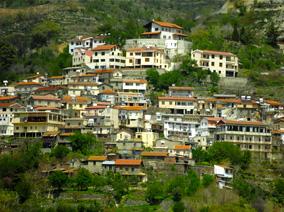
Winner in the Tourism and Local Intangible Heritage category
On the slopes of Mount Troodos, in the heart of the centrally-located Pitsilia region, Agros offers an authentic, traditional travel experience.
Its close proximity to all cities and the international airports of Larnaca and Pafos gives easy access by car and bus.
Agros is an ideal year-round rural destination to visit not only for its great countryside, but also for its local traditions and its cultural and religious sites. Named after a monastery from the 11th century, Agros was founded at the end of the 18th century, and developed its famous rosewater industry with the introduction of the Mesopotamian Rosa Damascena in the early 20th century. Agros therefore offers its visitors unique opportunities to participate in celebrations of local cultural heritage and nature’s beauty, like the rose festival in May.
The region east of Mount Olympos, known as Pitsilia, consists of 40 villages including Agros. Picturesque valleys are criss-crossed with vineyards and almond, hazelnut, walnut and other fruit trees. Pitsilia is known as the orchard of Cyprus. A good time to visit is in the spring, when the entire valley is in flower.
Agros village
Agros village is situated in the heart of the Pitsilia region in a beautiful valley, where wild roses grow in the hills. It is home to many historical and cultural sites and to special walking and hiking paths for those who love nature and enjoy discovering flora and fauna.
Its beautifully landscaped vineyards, almond trees, walnut trees, fruit orchards and perennial crystal clear water springs have earned Agros a very precious reputation as one of the island’s national treasures.
Nature trails
Through the Agros region there are three nature trails, ideal for taking in this idyllic setting. A walk through Agros village reveals important aspects of the tradition, history and culture of the region.
One of the most important museums of the island is the Frangoulidis museum. This folk art museum housed in a restored traditional building carries a selection of local arts and crafts. Its most interesting exhibits include a traditional olive mill.
Agros churches
Christianity is interwoven into Cypriot history and the village is also home to a fascinating 19th century monastery. The church of Panagia Eleousa erected on the ruins of the Agros monastery is an impressive piece of Byzantine architecture with a massive dome. The church also housed the icon of Panagia (Virgin Mary the Merciful) until 1990 when it was put in a nearby chapel.
The church of Timios Prodromos (John the Baptist) is a 19th century basilica monument in eastern Agros.
Agros wineries
Agros is situated on the path of a wine route through pine trees and grapevines which grow freely on the slopes of the mountain. The route includes two wineries: Vasilikon winery Kyperounta and Tsiakkas winery Pelendri.
Cultivating the rose and the rose festival
Roses have been an integral part in the Judaeo-Christian and Muslim traditions as a symbol of purity, devotion and love. Rose lovers will thoroughly enjoy a visit to Agros during May for the annual week-long rose festival, at the peak of rose blossom. The festival is full of activities, exhibitions and demonstrations, celebrating nature’s beauty and local traditions.
During the month of May, rose-growers pick around half a million rose buds during the early hours of morning while the leaves are still damp with morning dew. These flowers fill the whole region with a sensational fragrance. Villagers at Agros and the surrounding communities use the rose extract to produce rose oil, rosewater, liqueur and brandy. Rosewater also has many uses in Cypriot cuisine.
Various village workshops provide an array of products for sampling and purchase. The Agros traditional rosewater workshop provides products such as liqueur, brandy, sweets and perfumery all based on rosewater and rose oil.
Activities during the festival include handpicking roses in the fields, attending the rosewater-making process to learn about the benefits of the current application of rose products, participating in festivities to learn about the cultural symbolism of roses and their products. Along the festival grounds, local producers and the Agros women’s association offer Cypriot delicacies made with local recipes.
The cultivation of Rosa Damascena and the production of rose by-products are also at the heart of seminars and tours. Youth and cultural organisations hold poetry and theatre performances on the theme of the rose and the village of Agros, while folk groups dance to the sounds of local traditional music.
Cypriot cuisine
Agros restaurants and taverns preserve and promote traditional Cypriot cuisine. Gastronomic choices include a wide selection of famous Cypriot mezze and specialties such as halloumi (white cheese with herbs), traditional sweets like soutzioukos (grape juice dipping with nuts), machalepi (rice starch with rosewater syrup), fruit preserves, salted and dry-salted delicacies, well known pork products like pastourmas, spicy sausages and smoked products such as hiromeri (smoked ham), lountza (smoked fillet of pork) and bacon.
More information
- The official website of Florina
- Watch the EDEN video about Florina:
- Long version (3 minutes)
- Short version (1 minute)
- EDEN contact for Florina: naflo
 otenet [dot] gr (naflo[at]otenet[dot]gr)
otenet [dot] gr (naflo[at]otenet[dot]gr)
Troodos - 2007 Winner
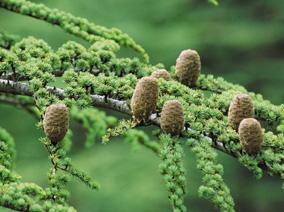
Best Emerging European Rural Destination of Excellence category
Troodos has five distinct regions, grouped around Mount Olympus, the highest mountain in Cyprus (1,952m):
- The Lemesos Mountain Resort region situated around the central higher elevations of the Troodos range, featuring pine covered village communities.
- The Pitsilia region (North and South) to the east of Mount Olympus, home to picturesque valleys covered with vineyards, almond, hazelnut, walnut and other fruit trees. A good time to visit is in the spring, when the entire valley is in full blossom.
- The Solea Valley to the north, situated along the main Lefkosia-Troodos road, a charming area of tranquil villages set in beautiful natural surroundings.
- The Marathasa Valley located on the northwestern slopes of the Troodos range. The valley is a fertile cherry producing area of small village communities and crystal water springs.
- The Krassochoria and Koumandaria region, located on the southern slopes of the Troodos range and known for its wine production. In recent years a number of small enterprises specialising in the production of local wine have emerged, establishing wine varieties of international standard.
Troodos provides a wide range of accommodation including hotels, traditional houses and agrotourism establishments. There is a choice of nearly 2,000 beds in various types of licensed establishments, from basic village accommodation to 4 star hotels. The area offers an abundance of things to do and see, including: walking or cycling through forest nature trails; attending local village festivals; experiencing the local traditional cuisine; and discovering the cultural treasures of UNESCO World Heritage sites. Birdwatchers, botanists, geologists, ramblers, bikers, photographers or nature lovers seeking a relaxing break away from the cosmopolitan coastal resorts will all be delighted.
Troodos National Forest Park covers an area of 9,337 hectares around the Olympus Mountain. The highest point is Chionistra (1,952m) and the lowest is the Moni forest (700m). The area is of great natural beauty and suitable for activities such as hiking, winter skiing, biking, nature study and picnics. Animal life is rich and protected. Of particular interest are the griffon vulture, the raven, the Bonellis eagle, the treecreeper, and the Cyprus pied wheatear.
The region’s geology includes a well-preserved ophiolite complex created from oceanic crust some 90 million years ago. Elements of this complex can be viewed walking along one of the many park nature trails.
Machairas National Forest Park in the Pitsilia region contains over 600 plant species, including 27 indigenous to Cyprus. The dominant forest trees are the calabrian pine (Pinus brutia) and the golden oak (Quercus alnifolia). Fauna includes foxes, hares, hedgehogs, snakes, lizards and rare endemic species of butterfly. Park birdlife includes the Bonelli’s eagle, the Cyprus warbler, the Cyprus wheatear, the coal tit, the scops owl, the jay, the chukar and wood pigeon. The two most important Cypriot rivers, Pediaios and Yialias, spring from the park.
Five nature protection areas reserves are found within the Troodos region, all included in the European network of areas ‘NATURA 2000’.
Cultivated vineyards cover a large percentage of Cyprus’ hilly and mountainous land, from sea level up to 1,500m. Most vineyards are located in the southern Troodos area predominantly on the slopes of the Krassochoria and Koumandaria region.
The region’s vineyards are the source of a sweet, robust dessert wine known as Koumandaria. Originally produced by the ‘Grand Commanderie’ of the Knights of the Order of St John of Jerusalem during the 14th century, it is considered to be the oldest named wine in the world.
Troodos is also the spiritual centre of Cyprus. It is where old painted churches, superb examples of Byzantine art, are located. Ten such churches, with their remarkable pitched wooden roofs, icons and frescoes have been designated as UNESCO World Heritage Sites. Troodos is also host to some of the most divine monasteries such as Kykkos, Trooditissa and Machairas.
Tradition and heritage form an important part of daily life in the area. It is home to many small museums and centres dedicated to traditional skills, environment, iconography and rural life. Local festivals commemorating the patron saint of a village are an integral part of life in the region. Other events cover a wide variety of themes such as folk art and craft festivals, bread, preserved sweets, meat and other local produce exhibitions and wine tasting events.
In addition to events that focus on local tradition and heritage, Troodos hosts a wide range of special leisure activities catering to all ages and tastes. These range from classic motorcar rallies to active day events where the whole family can try their skills at activities such as archery, horse riding or mountain biking.
More information
- The official website of Cyprus tourism
- The website of rural Cyprus tourism
- Watch the EDEN video about Troodos
- EDEN contact for Troodos: papplatres
 cytanet [dot] com [dot] cy (papplatres[at]cytanet[dot]com[dot]cy)
cytanet [dot] com [dot] cy (papplatres[at]cytanet[dot]com[dot]cy)
